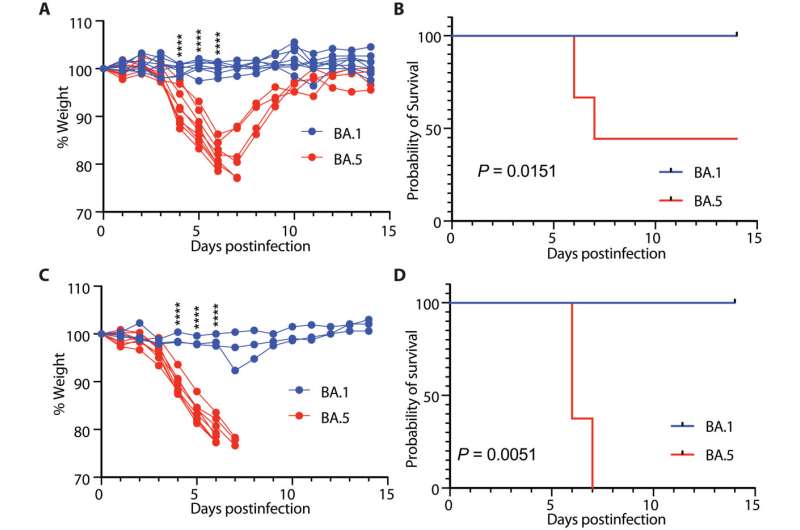This article has been reviewed according to Science X's editorial process and policies. Editors have highlighted the following attributes while ensuring the content's credibility:
fact-checked
peer-reviewed publication
trusted source
proofread
Contagious omicron strain found to replicate early in infection

Since the start of the COVID-19 pandemic in 2019, the SARS-CoV-2 virus has produced a number of variants, including alpha, beta, delta and omicron, each with its own subvariants.
New research, published Sept. 22 in Science Advances, used engineered mice to compare SARS-COV-2 omicron subvariants, and found one of them, BA.5, was more virulent likely due to its ability to rapidly replicate early during infection.
The study addresses a challenge to studying and understanding rapidly evolving variants of concern due to a lack of animal models for running tests that could help explain why variants and subvariants each behave differently in people.
The genetically modified mice, called K18-hACE2 mice, used in the research express a human receptor that allowed SARS-COV-2 to enter otherwise inaccessible mouse cells.
"One of the things we found is that the strain that causes more pathology, BA.5, replicates much faster early on during infection," said Avery August, deputy provost and professor of microbiology and immunology in the College of Veterinary Medicine (CVM). August and Hector Aguilar-Carreño, professor of virology, also in CVM, are co-corresponding authors of the study, "Age-Dependent Acquisition of Pathogenicity by SARS-CoV-2 omicron BA.5."
"By doing that, the virus generates a really strong immune response, which then leads to increased pathology and symptoms compared to subvariants that don't replicate as fast," August said.
"Prior to this study, there were no small animal models to study the new SARS-CoV-2 omicron variants of concern, because no animals got sick with other variants," Aguilar-Carreño said. "Our study allows us to use relatively older K18-hACE2 mice as a disease model to understand how the virus becomes pathogenic, and to test whether and how vaccines and antivirals work for the new omicron sub-variants."
Early omicron BA.1 and BA.2 subvariants also replicated and spread in the K-18 mice, but they caused minimal illness and death. On the other hand, BA.5-infected mice exhibited significant weight loss, high pathology in lungs, high levels of inflammatory cells and cytokines, signaling proteins that are associated with inflammation. While some 3-month old mice survived, all 5 to 8 month-old BA.5-infected mice died.
The animal model makes it possible for researchers to begin to tease apart components of the immune system that could be focused on or blocked to potentially lessen or eliminate disease. Some scientists believe that targeting cytokines with drugs could provide a potential treatment that tempers the immune response and lessens symptoms.
The researchers found many similarities between the mouse model and how these subvariants behave in humans, with BA.5 being more virulent in both. One big difference was that most people who developed illness from BA.5 didn't die, but in K-18 mice, the subvariant was particularly pathogenic and lethal.
An advantage of the mouse model is that all the mice are identical with the same genetic background. When studying humans, many variables—such as previous conditions, genetics and whether someone has previously been immunized or infected—can affect the pathological outcome of the disease.
"In order to really hone in on the components of the immune response, we use these mice that all have the same genetics, all are uniformly environmentally housed, have had no previous exposure to the virus, and then we can go back and ask if we see similar things in humans," August said.
Also, the mouse model allowed the researchers to examine disease in the lungs over time. "With BA.5, we see more pathology early on during the infection compared to mice infected with other strains or the control mice," August said. They also found higher viral loads in the strain that caused more infection, he said. Older mice were more affected by the virus than younger mice as well.
The studies were done in a high containment biosafety level 3 facility.
More information: Brian Imbiakha et al, Age-dependent acquisition of pathogenicity by SARS-CoV-2 Omicron BA.5, Science Advances (2023). DOI: 10.1126/sciadv.adj1736





















